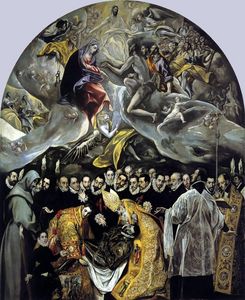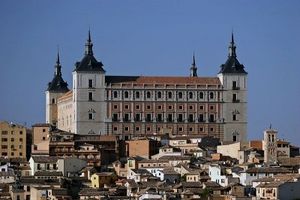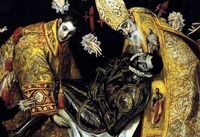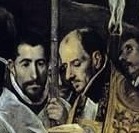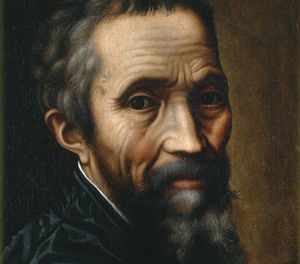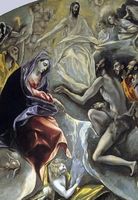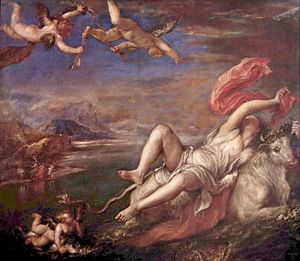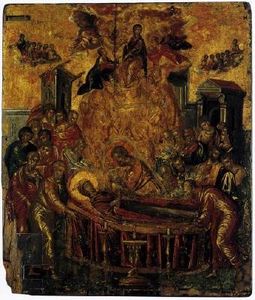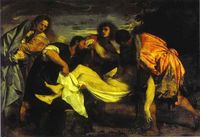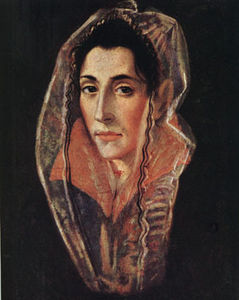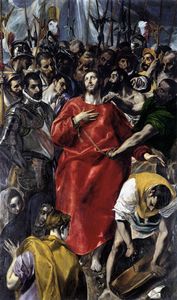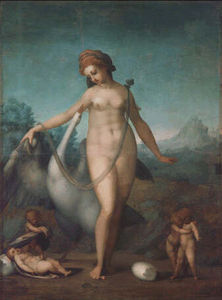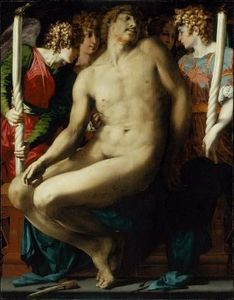The Burial of the Count of Orgaz
- Date of Creation:
- circa 1588
- Alternative Names:
- Entombment of the Count of Orgaz
- Height (cm):
- 480.00
- Length (cm):
- 360.00
- Medium:
- Oil
- Support:
- Canvas
- Subject:
- Scenery
- Art Movement:
- Mannerism
- Created by:
- Current Location:
- Toledo, Spain
- Displayed at:
- Santo Tome Church
- Owner:
- Santo Tome Church
- The Burial of the Count of Orgaz Page's Content
- Story / Theme
- Inspirations for the Work
- Analysis
- Critical Reception
- Related Paintings
- Artist
- Art Period
- Bibliography
The Burial of the Count of Orgaz Story / Theme
El Greco's The Burial of the Count Orgaz is universally considered his greatest masterpiece. Some even claim that this is the most beautifully crafted religious painting of all time.
Ever since El Greco completed the painting in the late 1500s, people have been flocking to the Santo Tome church in Toledo, Spain, where the impressive 16 by 10-foot image lives.
The Commission:
When the Count of Orgaz was alive, he donated a large sum of money to the Santo Tome church. After his death however, the officials in the town ignored his request to bequeath the money -for over 200 years.
Then came along Father Andres Nuñez, a humble priest at the Santo Tome who filed a lawsuit in 1569 and won back payments of the Count's original endowment.
The priest decided to use this money to decorate the church in honor of the Count and on March 15, 1586, he chose El Greco as the man for the job.
The theme of this painting is an historical-mystical series of events surrounding the death of local hero Count Orgaz, who died in his native Toledo in the early 1300s. The Count was said to be a pious man, a philanthropist, and a knight.
After the Count died in 1312, he was interred by the Cardinal and a host of clerics.
The story goes that during this ceremony, the heavens erupted spontaneously and friends and mourners witnessed a sky filled with images of Jesus, the Virgin, St. John, and several other saints and angels.
Legend explains that Saint Augustine and Saint Stephen appeared to reward the Count for his generosity to the church by burying him with their own hands and dazzling all those present.
Being a pious Toledan himself, El Greco chose to recapture this remarkable legend, painting both the mortals and immortals in attendance at Count Orgaz's funeral.
Paying Tribute:
By way of thanks for this commission, El Greco painted Nuñez into this masterpiece (located in the far right of the image). Furthermore, as a tribute to the aristocracy of Toledo, El Greco honored various prominent Toledan social figures by immortalizing them in the painting.
El Greco even allegedly painted himself, as the figure looking straight out toward the viewer next to Saint Stephen.
In addition to immortalizing Santo Tome's priest and several prominent men of Toledo, El Greco also honored his own son in The Burial of the Count of Orgaz. The young boy looking directly at viewers from the bottom left hand corner of the painting is Jorge Manuel, El Greco's beloved illegitimate son.
Inscribed on the handkerchief in his pocket are both El Greco's Greek signature and the date of his son's birth 1578.
The Burial of the Count of Orgaz Inspirations for the Work
El Greco's inspirations for this painting are a great topic of debate among contemporary art critics. Some say that he was inspired by Byzantine art, as evidenced by his earlier work, The Dormition of the Virgin. Others point to Renaissance and other Mannerist artists as particularly influential.
In addition to paintings and artists, El Greco was also inspired by the fine churchmen and influential members of Toledan society, the Count himself, and God, who served as El Greco's primary influence and inspiration throughout his life.
The Burial of the Count of Orgaz Analysis
Composition:
This image painting is clearly divided into two parts: heaven above and the moral burial scene below. Above in the heavens swirl unearthly clouds of ice and elongated phantomlike saints and angels in El Greco's typical Mannerist style.
Below terrestrial scene is painted in normal proportions. Because the painting lacks ground, horizon, and perspective, it achieves supernatural space and creates a strange species of harmony.
Color palette:
The composition is brought together through rich gold and red colors, which produce a royal and ceremonial character, making the image more cohesive. The figures' varied participation in both the earthly and heavenly events and the torches and cross stretching upward from the terrestrial scene help create harmony in the image.
Several areas of this painting shimmer and dance with an unmatchable glow. El Greco put so much care into the detail of this work, that even the brilliant garments of his figures are masterpieces in their own right.
The Burial of the Count of Orgaz Critical Reception
The Burial of the Count of Orgaz has long been considered one of El Greco's finest paintings. From its early reception by the Toledans, who undoubtedly held this tributary painting in high regard, to the contemporary critics and visitors who still flock in droves to see this masterpiece, The Burial of the Count of Orgaz has generally been received with overwhelming praise.
Much of the critical reception of this work has focused on El Greco's inspirations for the piece. While many believe that this painting marks El Greco's first major departure from his Renaissance and Mannerist mentors, others try to draw close parallels between this painting and related works by predecessors like Titian and Tintoretto.
Contemporary Reception:
1960s:
Harold Wethey:
A 20th century critic, Wethey asserts that the impressive array of portraits and the supernatural vision of heaven depicted in The Burial of the Count of Orgaz, reveals El Greco's extraordinary artistic genius.
1990s:
Marina Lambraki-Plaka:
This contemporary art critic regards this work as a landmark in El Greco's career. She states: "This is where El Greco sets before us, in a highly compressed form the wisdom he has brought to his art, his knowledge, his expertise, his composite imagination and his expressive power. It is the living encyclopedia of his art without ceasing to be a masterpiece with organic continuity and entelechy."
The Burial of the Count of Orgaz Related Paintings
The Burial of the Count of Orgaz Artist
This painting marks El Greco coming into his own. For the first time we see him shirk his reliance on Roman or Venetian formulas or motifs in favor of his own Mannerist, but more aptly El Greconian, style.
El Greco was born in Crete, during the time it was part of the Republic of Venice and a hub of Post-Byzantine art. He became a master in this art form before following in the footsteps of other Greek artists and travelling to Venice to further his studies.
Moving on to Rome, El Greco opened a workshop and spent a great deal of time developing his style, adopting elements of both Mannerism and the Venetian Renaissance.
However, it was after relocating to Toledo, Spain that El Greco truly blossomed. There he received several major commissions and produced his best known paintings.
The artist gained notoriety for his highly expressive and visionary religious works and rarely ventured away from this genre. When he did, however, he created compelling portraits, landscape paintings, mythological works and sculptures, and those produced during his later years are particularly notable for their undulating forms, epic scale and expressive distortions.
El Greco regarded color as the most important element of painting, and declared that color had primacy over form. In his mature works he tended to dramatize rather than describe and the strong spiritual emotion of his works directly affects the audience.
The Burial of the Count of Orgaz Art Period
El Greco completed this painting during the Mannerist period, which, following on the heels of the High Renaissance, spanned the time from 1520 to about 1590.
El Greco's elongated figures, dissonant use of light, brilliant colors, artificiality, and lack of depth in The Burial of the Count of Orgaz are quintessential elements of the Mannerist style.
Mannerism was a period of European art history that followed close on the heels of the Renaissance. In fact, this period is sometimes referred to as the Late Renaissance.
While El Greco was technically considered a Mannerist, this early work is very reminiscent of Byzantine art, by which El Greco was heavily influenced.
El Greco's works were worlds apart from his contemporaries due to their dramatic and expressionistic style and it was not until the 18th century that his unique approach was appreciated.
The artist is seen as a forerunner of both Expressionism and Cubism and he also inspired writers and poets including Rainer Maria Rilke and Nikos Kazantzakis.
Marrying Byzantine traditions with Western painting, El Greco is renowned his elongated figures and often fantastic pigmentation and because of this many modern scholars believe that El Greco is a truly unique artists who broke the rules of all conventional schools.
Many regard El Greco as one of the finest painters of Spain, if not all of Western Art.
The Burial of the Count of Orgaz Bibliography
To read more about El Greco please choose from the following recommended sources.
• Alcolea, Santiago. El Greco. Ediciones Poligrafa, 2007
• Bray, Xavier. El Greco (National Gallery of London). Yale University Press, 2004
• Carr, Dawson W. El Greco to Goya: Spanish Painting (National Gallery Company). Yale University Press, 2009
• Davies, David. El Greco (National Gallery Company). Yale University Press, 2005
• Kazantzakis, Nikos. Report to Greco. Faber and Faber, 2001
• Scholz-Hansel, Michael. El Greco: Domenikos Theotokopoulos 1541 - 1614 (Taschen Basic Art Series). Taschen GmbH, 2004

